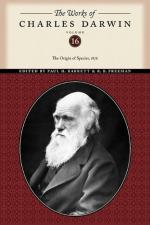Now let us apply these facts and the above two principles—which latter, though not proved true, can be shown to be in some degree probable—to species in a state of nature. Let us take a genus of birds, descended on my theory from some one parent-species, and of which the several new species have become modified through natural selection in accordance with their diverse habits. Then, from the many slight successive steps of variation having supervened at a rather late age, and having been inherited at a corresponding age, the young of the new species of our supposed genus will manifestly tend to resemble each other much more closely than do the adults, just as we have seen in the case of pigeons. We may extend this view to whole families or even classes. The fore-limbs, for instance, which served as legs in the parent-species, may become, by a long course of modification, adapted in one descendant to act as hands, in another as paddles, in another as wings; and on the above two principles—namely of each successive modification supervening at a rather late age, and being inherited at a corresponding late age—the fore-limbs in the embryos of the several descendants of the parent-species will still resemble each other closely, for they will not have been modified. But in each individual new species, the embryonic fore-limbs will differ greatly from the fore-limbs in the mature animal; the limbs in the latter having undergone much modification at a rather late period of life, and having thus been converted into hands, or paddles, or wings. Whatever influence long-continued exercise or use on the one hand, and disuse on the other, may have in modifying an organ, such influence will mainly affect the mature animal, which has come to its full powers of activity and has to gain its own living; and the effects thus produced will be inherited at a corresponding mature age. Whereas the young will remain unmodified, or be modified in a lesser degree, by the effects of use and disuse.
In certain cases the successive steps of variation might supervene, from causes of which we are wholly ignorant, at a very early period of life, or each step might be inherited at an earlier period than that at which it first appeared. In either case (as with the short-faced tumbler) the young or embryo would closely resemble the mature parent-form. We have seen that this is the rule of development in




